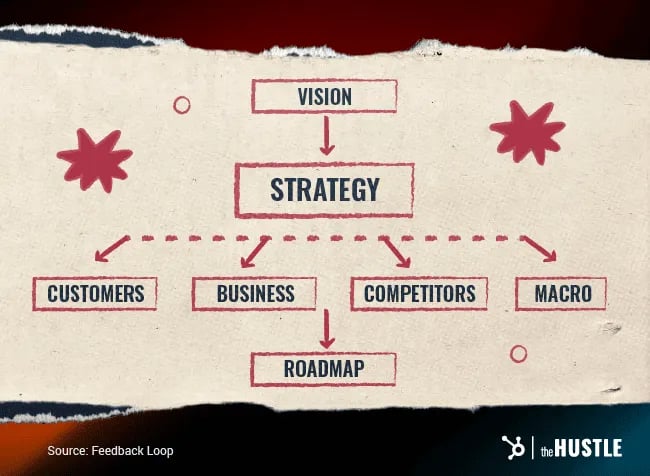To create innovative and beloved products, companies have to understand their buyers, identify the problems they want to solve, and then develop and launch the solution successfully.

An important part of the process: having a product strategy that integrates different aspects of product development, and serves as a compass for the entire organization.
What Is Product Strategy?
Product strategy is the overarching plan explaining what your business aims to achieve with a product or feature. It includes how you plan to create the product, how it will impact buyers, and how it helps achieve your business goals.
It guides the ideation, creation, and launch of your product. Though some products — such as the microwave and super glue — happen accidentally, the majority of successful products have an underlying, high-level product strategy to back it up.
Having a cohesive strategy helps different teams stay on track, and they will refer to it when they have questions or need to make decisions. Once you have a solid strategy set, you can then build out a product roadmap and, eventually, the actual product.
Product Strategy Framework Components
A product strategy often includes three core components: your market vision, product goals, and product initiatives.
Market Vision
Your market vision includes two aspects: the target audience and the business opportunity. It highlights how you plan to position the product and how it compares to competitors. Your vision should also explain how you plan to deliver a competitive offer that solves customers’ problems.
For example, a software company that creates a product management tool, similar to Asana or Trello, might include the following in their market vision:
- Audience: executive-level product managers
- Product positioning: an intuitive, easy-to-use interface for less technologically savvy users
- Competition: existing products are unspecialized, clunky, and hard to use
Product Goals
When measuring the success of a strategy, you need time-bound, measurable goals. For example, you could set a goal of having a customer retention rate of 97% or driving $50m+ in revenue in three years.
A goal addresses a specific problem you aim to solve, usually with a tangible way of measuring progress.
Product Initiatives
Alongside specific goals, your product strategy should have a complementary big-picture component. An initiative should explain your company’s focus and areas of investment. For example, you might set an initiative to improve the responsiveness of an app.
Unlike a goal, an initiative involves complex planning that brings together multiple stakeholders to achieve long-term success, often spanning the entire product life cycle.
Many use goals as the foundation for their initiatives. For example, you might set a goal of reducing the churn rate by 15% in one year. An initiative, then, might be improving the performance and responsiveness of the app.
Product Strategy Examples
Consider a company that creates time management software. When crafting their product strategy, they might include:
- Market vision: Create time management tools for senior managers in the software-as-a-service industry by providing an intuitive, easy-to-use interface — unlike competitors with clunkier software
- Product goal: Maintain a retention rate of 98% in the first year
- Product initiative: Improve the product's user experience and interface
Their market vision explains their target audience (senior management) alongside their competitive offering (an easy-to-use, UX-friendly interface).
Their product goal has a time constraint and a specific, measurable objective. The initiative — which has a more high-level aspect — complements the product goal, as improving user experience will likely increase retention rate.
Using another example, an artificial intelligence writing startup might have the following components in their product strategy:
- Market vision: Create an easy-to-use AI writing tool for small-business owners looking to save money on SEO and content creation — unlike competitors with unfocused writing tools
- Product goal: Acquire 500 users in the first three months
- Product initiative: Measure and optimize marketing campaigns promoting the AI tool
The company’s market vision explains both their audience and their differentiating factor. Similarly, their goal of acquiring a certain number of users goes hand in hand with their initiative — optimizing their product’s marketing.
The Importance of Having a Product Strategy
A product strategy gives teams direction — 35% of product teams reported wishing they had a clearer vision and purpose. It can also help your company increase collaboration, improve communication, and create better products.
Communicates Organizational Goals
A product strategy centers different stakeholders — including customer service, marketers, salespeople, and engineers — on one goal.
Although product managers, engineers, and developers may handle the day-to-day aspects of executing a product strategy, other departments need to know the product’s direction. For example, marketing and sales need to understand the most valuable features to create targeted promotions and advertisements.
Given that almost nine in 10 professionals blame a lack of communication for workplace failure, a product strategy can keep everyone aligned.
Defines Your Product’s Place in the Market
It’s near impossible to serve everyone in a market — and many startups fail because they misread market demand.
A product strategy helps set you apart from competitors because it answers the why behind your product. Creating a detailed plan forces you to spend time thinking about how to differentiate it from your rivals.
Enables the Creation of a Product Roadmap
As a result of creating a product strategy, you’ll set goals — both big-picture and specific ones. You can then use them as the basis for a detailed product roadmap. Since organizations waste 12% of resources due to ineffective product management, a solid product strategy optimizes that process.

Types of Product Strategies
Cost Strategy: Creating the best product for the lowest possible cost. This strategy works well in industries where customers put little thought into purchases, such as household cleaning products or toothbrushes.
Differentiation Strategy: Creating a product with a unique, standout feature. This can include a never-before-seen feature on a product or creating a product with whacky branding.
Focus Strategy: Creating a product that targets one specific buyer persona. This means focusing all your energy on a small set of people. You end up creating highly personalized products that gain significant brand loyalty.
Quality Strategy: Creating a product only using high-quality materials. This strategy naturally targets customers who have limited concern for price. To them, the quality or prestige justifies the high price — such as a luxury handbag.
Service Strategy: Creating a product complemented by high-quality customer service. Though the product still has to meet customer needs, this strategy leverages effective customer service to help build brand loyalty.
How To Create a Product Strategy
Creating a product strategy comes down to figuring out your market vision, product goals, and product initiatives.
Create Your Market Vision
Your market vision is a high-level overview of your company, competitors, your buyers, and your concept. To create it, consider jotting down bullet points for the following:
- Competitors: What companies currently dominate the market?
- Company weaknesses: Where does your company struggle?
- Company strengths: Where does your company excel?
- Buyer personas: Who is your target audience?
- Marketspace: What does the industry look like?
- Go-to-market plan: How will you promote your solution?
Set Product Goals
Next, set product goals for your strategy. Make them both time-bound and numbers-oriented, so you can measure progress and success throughout the process. To start, write down a few notes for the following:
- Timeline: Is it flexible or rigid? How volatile is the market?
- Metrics: What metrics does your business care the most about? What does your business hope to achieve with the product?
- Teams: What internal stakeholders should be in the know? How can you best keep them informed?
Create Product Initiatives
Product initiatives require less specificity than product goals — but they complement each other. You want to understand your company’s big picture. So, look through your goals and see how they relate to more high-level aspirations.
To help you get started, try these different methods:
- Collaborate with stakeholders: Ask others in the organization. What areas do they want to prioritize? Where do they see the company investing its time and resources in?
- Look at buyer personas: What do they care about most? Where do you foresee them having problems using your product?
- Analyze your company: What does your company need the most? Money? Users? Publicity?



